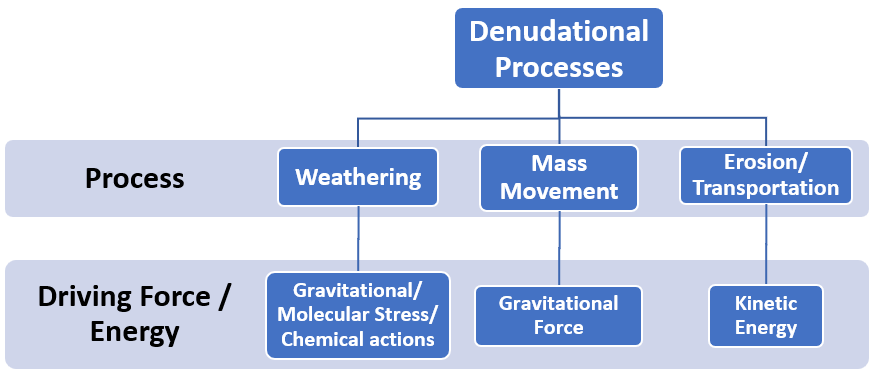Exogenic Process:
The processes which occur on the surface of the earth under the influence of exogenic forces are termed exogenic processes or exogenic geomorphic processes. They derive energy from the atmosphere determined by ultimate energy from the sun, potential energy arising from the gravitational attraction of the Earth and gradients created by tectonic factors.
They are supported by the following factors:
- Gravitational force: It tends to produce movement of matter in a downslope direction.
- Stress: It breaks rocks and other materials.
- Shear stress results in angular displacement or slippage.
- Molecular stresses caused due to temperature changes, crystallisation and melting
- Chemical processes: Normally lead to the loosening of bonds between grains, dissolving of soluble minerals or cementing materials.
- Temperature and precipitation are two important elements that control various processes.
Denudation:
The word ‘denude’ means to strip off or to uncover. Weathering, mass wasting/movements, erosion and transportation are included in denudation. The flow chart below gives the denudation processes and their respective driving forces. It should become clear from the chart that for each process there exists a distinct driving force or energy. It consists of weathering, mass wasting or movement, erosion and transportation of earth mater
Factors influences Denudation:
The denudation process is mainly influenced by the action of exogenic geomorphic processes, i.e. gravity, geomorphic stresses, chemical processes, temperature and precipitation. The impact of these primary factors is different in different regions. The following are the secondary factors that impact the denudational processes on Earth:
- Climatic Conditions: There are different climatic regions owing to variations in thermal gradients created by latitudinal, seasonal, and land and water spread on the surface of the earth. These variations impact the exogenic geomorphic processes in different regions differently.
- Amount of vegetation: The density, type and distribution of vegetation which largely depend upon precipitation and temperature also exert influence indirectly on exogenic geomorphic processes.
- Amount of Insolation: Within different climatic regions, there may be local variations in the effects of the amount of insolation received by north and south-facing slopes as compared to different climatic elements due to altitudinal differences, aspect variations and the variation in the east and west-facing slopes.
- Wind velocities and Directions: It impacts the amount and kind of precipitation, its intensity, the relation between precipitation and evaporation, the daily range of temperature, freezing and thawing frequency, depth of frost penetration, and the geomorphic processes vary within any climatic region.
- Type and Structure of Rocks: Climatic factors being equal, the intensity of denudation depends upon the type and structure of rocks, i.e. their folds, faults, orientation and inclination of beds, presence or absence of joints, bedding planes, hardness or softness of the minerals, its chemical susceptibility and permeability etc. Different types of rocks with differences in their structure offer varying resistances to various geomorphic processes in varying climatic conditions. Hence, they operate at differential rates and give rise to differences in topography.
The effects of most of the exogenic geomorphic processes are small and slow and may be imperceptible in a short period, but will in the long run affect the rocks severely due to continued fatigue.
Some of the exogenic geomorphic processes are:
- Weathering:
- Mass Movements:
- Erosion and Deposition
Weathering:
Weathering is defined as the Mechanical disintegration and chemical decomposition of rocks through the actions of various elements of weather and climate.
Several processes act either individually or together to affect the earth’s materials to reduce them to a fragmental state. It is an in-situ or on-site process, as very little or no motion of materials takes place in weathering. The process of weathering is conditioned by many complex geological, topographic, climatic, and vegetative factors. Climate played the most vital role.
There are three major groups of weathering processes:
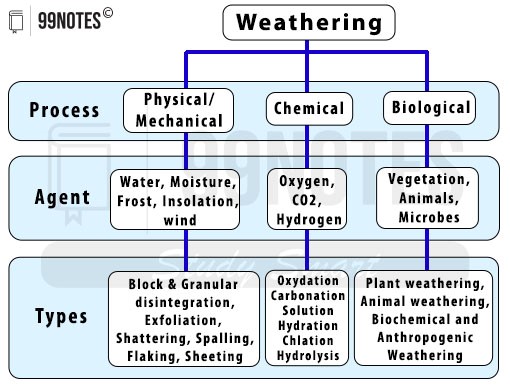
Physical Weathering Processes:
Physical or mechanical weathering processes depend on some applied forces. The applied forces could be:
- Gravitational forces such as overburden pressure, load and shearing stress;
- Expansion forces due to temperature changes, crystal growth or animal activity;
- Water pressures that are controlled by wetting and drying cycles.
Many of these forces are applied both at the surface and within different earth materials leading to rock fracture. Most of the physical weathering processes are caused by thermal expansion and pressure release.
These processes are small and slow but can cause great damage to the rocks because of the continued fatigue the rocks suffer due to the repetition of contraction and expansion.
- Unloading and expansion:
Removal of overlying rock load because of continued erosion causes upper layers of the rock to expand, producing fractures that develop roughly parallel to the ground surface.
In areas of curved ground surface, arched fractures tend to produce massive sheets or exfoliation slabs of rock – resulting from expansion due to unloading and pressure release may measure hundreds or even thousands of metres in horizontal extent. Large, smooth rounded domes called exfoliation domes.
2. Temperature Changes and Expansion:
Due to differential heating, Surface layers of the rocks tend to expand more than the rock at depth and this leads to the formation of stress within the rock – making the rocks weak due to continued fatigue, resulting in heaving and fracturing, parallel to the surface is called as Onion peeling.
Exfoliation from the surface results in smooth rounded surfaces in rocks. With diurnal changes in temperatures, internal movement among the mineral grains of the superficial layers of rocks takes place regularly. Most effective in dry climates and high elevations where diurnal temperature changes are drastic.
Rocks like granites, smooth surfaced and rounded small to big boulders called tors form due to such exfoliation. Exfoliation domes and tors result from unloading and thermal expansion respectively.
| Exfoliation Dome | Exfoliation Tors |
| Exfoliation domes are typically found in uplifted areas, | Exfoliated tors are more commonly found in lower-lying areas. |
| Formed by unloading and expansion. | Formed by thermal expansion. |
| Typically have a smoother surface than exfoliated tors. | Have a rougher surface than an exfoliated dome. |
Occurs due to the growth of ice within pores and cracks of rocks during repeated cycles of freezing and melting. Most effective at high elevations in mid-latitudes where freezing and melting are often repeated. Glacial areas are subject to frost wedging daily.
The rate of freezing is important. Rapid freezing of water causes its sudden expansion and high pressure – resulting expansion affects joints, cracks and small intergranular fractures to become wider and wider till the rock breaks apart.
4. Salt Weathering:
Salts in rocks expand due to thermal action, hydration and crystallisation. Calcium, sodium, magnesium, potassium and barium tend to expand.
- Thermal action: The expansion of these salts depends on temperature and their thermal properties. High-temperature ranges between 30 and 50oC of surface temperatures in deserts favour such salt expansion.
- Hydration: Salt crystals in near-surface pores cause the splitting of individual grains within rocks, which eventually fall off and may result in granular disintegration or granular foliation.
- Salt crystallisation: Most effective in areas with alternating wetting and drying conditions, salt crystal growth is favoured and the neighbouring grains are pushed aside. Sodium chloride and gypsum crystals in desert areas heave up overlying layers of materials and as a result, polygonal cracks develop all over the heaved surface. Chalk breaks down most readily, followed by limestone, sandstone, shale, gneiss, granite etc.
Chemical Weathering Processes:
Chemical weathering consists of solution, carbonation, hydration, oxidation and reduction that act on rocks to decompose, dissolve or reduce them to a fine clastic (rocks composed of broken pieces of older rocks) state through chemical reactions by oxygen, surface and/or soil water and other acids. Water, air and heat speed up these chemical reactions.
- Solution:
Rocks are often composed of soluble minerals like nitrate, sulphates and Phosphate. In rainy climates, these minerals are easily leached out without leaving any residue, which then accumulates in dry regions in the form of salts such as Sodium. The material was removed in a solution without leaving any residue resulting in cave formation.
2. Carbonation:
Minerals like calcium carbonate and calcium-magnesium bicarbonate present in limestone are soluble in water containing carbonic acid. When Carbon dioxide (CO2) from air is mixed with water, it forms Carbonic acid. It acts as a weak acid and reacts with such minerals.
CO2 produced by decaying organic matter along with soil water greatly aids in the formation of Carbonic acid. Reaction of carbonate and bicarbonate with minerals enables the breaking down of feldspars and carbonate minerals.
3. Hydration:
Minerals take up water and expand; this causes an increase in the volume of the material itself. Calcium sulphate takes in water and turns into Gypsum (more unstable than calcium sulphate). It is a reversible and long process; continued repetition of this process causes fatigue in the rocks and may lead to their disintegration. Volume changes also help in physical weathering through exfoliation and granular disintegration.
Many clay minerals swell and contract during wetting and drying and a repetition results in cracking of overlying materials. Salts in pore spaces undergo rapid and repeated hydration and help in rock fracturing.
4. Oxidation and Reduction:
The minerals most commonly involved in this process are iron, manganese, sulphur etc. In oxidation, rock breakdown occurs. The red colour of iron upon oxidation turns to brown or yellow. When oxidised minerals are placed in an environment with no O2, reduction takes place. The red colour of iron upon reduction turns to greenish or bluish-grey.
Usually process happens below the water table, in areas of stagnant water and waterlogged ground.
Biological Activity and Weathering:
Removal of minerals and ions from the weathering environment and physical changes due to the growth or movement of organisms.
- Burrowing and wedging by organisms like earthworms, termites, rodents etc., helps in exposing the new surfaces to chemical attack and assists in the penetration of moisture and air.
- Human beings by disturbing vegetation, ploughing and cultivating soils, also help in mixing and creating new contacts between air, water and minerals in the earth’s materials.
- Decaying plant and animal matter helps in the production of humic, carbonic and other acids, which enhance decay, and solubility of some elements.
- Algae utilise mineral nutrients for growth and help in the concentration of iron and manganese oxides.
- Plant roots exert tremendous pressure on the earth’s materials mechanically breaking them apart.
Significance of weathering:
- Formation of soil: Weathering processes are responsible for breaking down the rocks into smaller fragments and preparing the way for the formation of not only regolith and soils but also erosion and mass movements. Weathering is an important process in the formation of soils
- Forest and Vegetation: Biomes and bio-diversity are basically a result of forests (vegetation) and forests depend upon the depth of weathering mantles.
- Erosion and Mass wasting: Erosion cannot be significant if the rocks are not weathered. That means weathering aids mass wasting, erosion and reduction of relief and changes in landforms are a consequence of erosion.
- Mineral and Mining: The weathering of rocks and deposits helps in the enrichment and concentrations of certain valuable ores of iron, manganese, aluminium, copper etc., which are of great importance to the national economy.
When rocks undergo weathering, some materials are removed through chemical or physical leaching by groundwater and thereby the concentration of remaining (valuable) materials increases. Without such a weathering taking place, the concentration of the same valuable material may not be sufficient and economically viable to exploit, process and refine. This is what is called enrichment.
Mass Movements:
Transfer of mass of rock debris down the slope under the direct influence of gravity. That means, air, water or ice do not carry debris with them from place to place but on the other hand the debris may carry with it air, water or ice. The movements of mass may range from slow to rapid, affecting shallow to deep columns of materials and include creep, flow, slide and fall. Gravity exerts its force on all matter, both bedrock and the products of weathering. So, weathering is not a pre-requisite for mass movement though it aids mass movements.
Mass movements are very active over weathered slopes rather than over unweathered materials. Mass movements are aided by gravity and no geomorphic agents like running water, glaciers, wind, waves and currents participate in the process of mass movements. That means mass movements do not come under erosion though there is a shift (aided by gravity) of materials from one place to another.
Materials over the slopes have their own resistance to disturbing forces and will yield only when force is greater than the shearing resistance of the materials. Weak unconsolidated materials, thinly bedded rocks, faults, steeply dipping beds, vertical cliffs or steep slopes, abundant precipitation and torrential rains and scarcity of vegetation etc., favour mass movements.
Several activating causes precede mass movements. They are:
- removal of support from below to materials above through natural or artificial means;
- increase in gradient and height of slopes;
- overloading through the addition of materials naturally or by artificial filling;
- overloading due to heavy rainfall, saturation and lubrication of slope materials;
- removal of material or load from over the original slope surfaces;
- occurrence of earthquakes, explosions or machinery;
- excessive natural seepage;
- heavy drawdown of water from lakes, reservoirs and rivers leading to slow outflow of water from under the slopes or river banks;
- indiscriminate removal of natural vegetation. Heave (heaving up of soils due to frost growth and other causes), flow and slide are the three forms of movement.
Heave (heaving up of soils due to frost growth and other causes), flow and slide are the three forms of movements
Landslides:
These are relatively rapid and perceptible movements. The materials involved are relatively dry. The size and shape of the detached mass depends on the nature of discontinuities in the rock, the degree of weathering and the steepness of the slope. Depending upon the type of movement of materials several types are identified in this category.
- Slump: It is the slipping of one or several units of rock debris with a backward rotation with respect to the slope over which the movement takes place (Figure 5.4).
- Debris slide: Rapid rolling or sliding of earth debris without backward rotation of mass is known as debris slide. Debris fall is nearly a free fall of earth debris from a vertical or overhanging face.
- Rockslide: The sliding of individual rock masses down bedding, joint or fault surfaces is rockslide. Over steep slopes, rock sliding is very fast and destructive. Slides occur as planar failures along discontinuities like bedding planes that dip steeply.
- Rockfall is free falling of rock blocks over any steep slope keeping itself away from the slope. Rock falls occur from the superficial layers of the rock face, an occurrence that distinguishes it from rockslide which affects materials up to a substantial depth.
Landslide in the Himalayas and Western Ghats:
Why do debris avalanches and landslides occur very frequently in the Himalayas?
There are many reasons for this.
- The Himalayas are tectonically active.
- They are mostly made up of sedimentary rocks and unconsolidated and semi-consolidated deposits.
- The slopes are very steep.
Landslides in Western Ghats:
- The Western Ghats along the west coast are relatively tectonically stable and are mostly made up of very hard rocks; but, still, debris avalanches and landslides occur though not as frequently as in the Himalayas, in these hills. Why?
- Many slopes are steeper with almost vertical cliffs and escarpments in the Western Ghats and Nilgiri hills.
- Mechanical weathering due to temperature changes and ranges is pronounced.
- They receive heavy amounts of rainfall over short periods. So, there is almost direct rock fall quite frequently in these places along with landslides and debris avalanches.
Erosion and Deposition
Erosion:
It involves the acquisition and transportation of rock debris. Rocks break into smaller fragments through weathering and any other process, erosional geomorphic agents like running water, wind and waves transport it to other places. By erosion, relief degrades, i.e., the landscape is worn down.
Abrasion by rock debris carried by these geomorphic agents also aids greatly in erosion. Though weathering aids erosion it is not a pre-condition for erosion to take place.
Weathering, mass-wasting and erosion are degradational processes. It is erosion that is largely responsible for continuous changes that the earth’s surface is undergoing. Denudational processes like erosion and transportation are controlled by kinetic energy.
Geomorphic agents:
- The erosion and transportation of earth materials are brought about by wind (gaseous medium), running water, waves, groundwater (liquid medium) and glaciers (solid medium).
- Of these, the wind, running water and glaciers are controlled by climatic conditions. The work of the other two agents of erosion – waves and groundwater is not controlled by climate. In the case of waves, it is the location in the coastal region — that will determine the work of waves.
- The work of groundwater is determined more by the ground characteristics of the region. If the rocks are permeable and soluble and water is available only then karst topography develops. We will discuss this in the next chapter.
Types of Erosion
Soil erosion is the process by which top most soil is removed from the surface of the earth by exogenetic processes such as water flow, wind and then transported and deposited in other locations.
In simple terms, soil erosion means the physical displacement of top most soil by various agents, including rain, water flowing over and through the soil profile, wind, glaciers or gravitational pull. Soil erosion can broadly be categorized into the following types:
- Water Erosion
- Wind Erosion
- Glacial erosion
- Gravitational Erosion
1. Water erosion: water erosion is the loss of topsoil due to water movement. It is simply caused by water as an agent and is called water erosion. In water erosion, the water acts as an agent to dislodge and transport the eroded soil particles from one area to another.
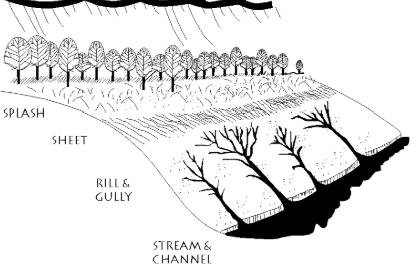
This is further classified as follows :
- Raindrop Erosion/splash Erosion
- Sheet Erosion
- Rill erosion
- Gully erosion
- Stream bank erosion
- Landslide
- Ravine formation
- Coastal Erosion
Raindrop Erosion/Splash Erosion: It is adifferential soil movement caused by raindrop splash. The detachment of soil particles occurring due to the impact of falling raindrops is known as raindrop erosion or splash erosion. It isconsidered to be the first step in the erosion process.
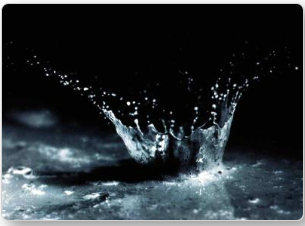
Sheet Erosion: the removal of soil in very thin layers or sheets of soil from the earth’s surface caused by running water from slopping land, which is known as sheet erosion. It results in the loss of the very fine soil particles that contain most of the available nutrients and organic matter in the soil.
Rill Erosion: It is anadvanced form of sheet erosion which occurs due to the concentration of flowing water. These are shallow drainage lines where the water begins to collect in the form of depressions and begins to erode the soil. This form of erosion adopts numerous narrow and straighter channels called rill
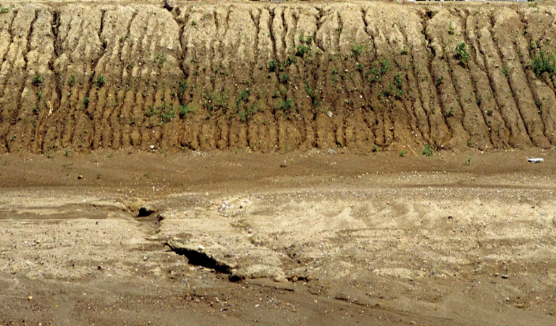
Gully Erosion: It occurs when rills continue to extend in depth, width, and length and become more serious. Gullies are channels deeper than 30 cm that normal cultivation cannot remove. Gullies occur when smaller water flows concentrate and cut a channel through the soil. Gullies formed over a region give rise to badland topography
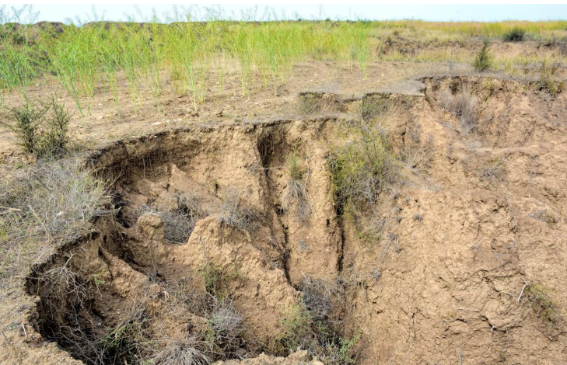
Stream bank erosion: Stream bank erosion occurs where streams begin due to increased peak flows or the removal of local protective vegetation; it is also the scouring of soil material from the stream bed. It is common along rivers, drains and streams where banks have been eroded or undercut

Ravine Formation: Ravinesare formed by the action of a stream that erodes the land. A ravine is unlike canyon or a valley with steep sides but smaller. For example: Ravines (Bihad) of Chambal are particularly famous.
Coastal erosion: It is the process by which local sea level rise, quite strong wave action, and coastal flooding wear down or carry away debris, rocks, soils, and sand along the coast.
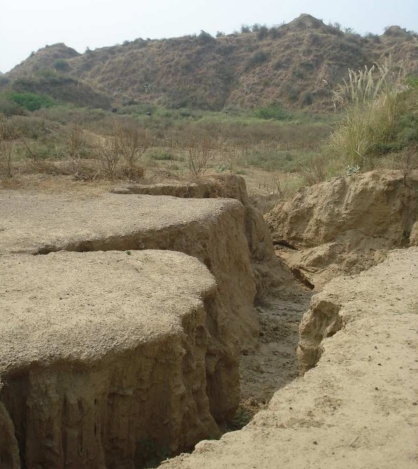
2. Wind Erosion: this erosion occurs when the soil is exposed to the dislodging force of wind. The intensity of wind erosion varies with surface roughness, slope, and types of cover on the soil surface, as well as wind velocity, duration, and angle of incidence.
Wind moves the soil in three ways: saltation, surface creep, and suspension.

- Saltation occurs when the wind lifts very large particles off the ground for short distances, leading to sand drifts.
- Surface creep: It occurs along with saltation. The large soil particles which are too heavy to be lifted into the air are moved through a process known as surface creep. In this process, the soil particles are rolled across the surface after coming into contact with the particles in saltation.
- Suspension: it occurs when the wind lifts very fine particles into the air, leading to dust storms.
3. Glacial Erosion: It is also known as Ice Erosion. It is common in cold regions at high altitudes. When the soil comes in its contact with large moving glaciers, it sticks to the base of the glaciers.
4. Gravitational Erosion: it is basically the mass movement of soil due to gravitational force. For instance, landslides.
Deposition:
When erosional agents lose their velocity and energy, the materials carried by them start to settle down. This is known as Deposition. The coarser materials get deposited first and finer ones later. By deposition depressions get filled up, and new landforms such as plains and coastlines are made. We shall visit such landforms in the next chapter.
In other words, deposition is not actually the work of any agent, but a consequence of erosion. The same erosional agents viz., running water, glaciers, wind, waves and groundwater also act as aggradational or depositional agents.

